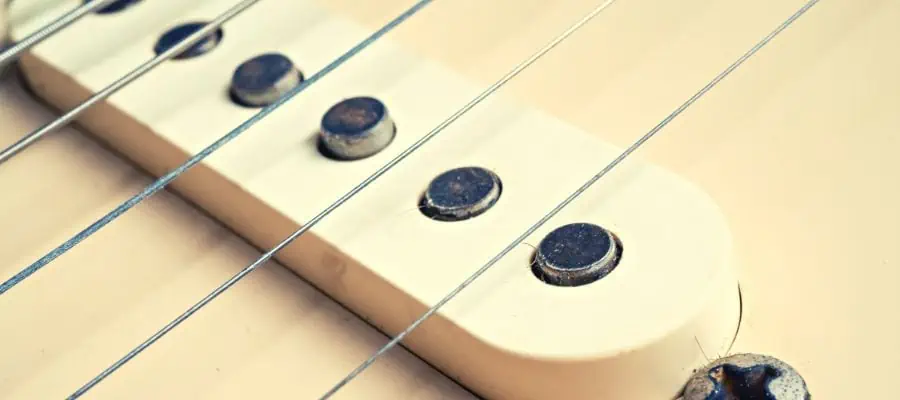Fender Stratocaster is the worldwide archetype when talking about electric guitars. The quintessential electric guitar is one of the first images that comes to mind when somebody mentions electric guitar. With its 60 years of history and unique design, the guitar became a legend among musicians and non-musicians alike.
The iconic design of Strat features 3 single-coil pickups. It was the first design with 3 pickups when it came out, and the reason was to increase the guitar’s sonic versatility. By placing three pickups, Fender allowed players to have a broader range of tonal qualities with different pickup combinations.
Playing the different parts of the string creates different tonal output, and having three pickups in different positions also increases the sonic possibilities. So, by capturing the string vibration in three other points, Fender aimed to give more tonal variety potential to the players.
Let’s dive deeper into the topic to learn about the history of the three-pickup design as well as what it brings to guitarists.
Advantages of the Three-Pickup Design

Multiple-pickup designs make the instruments capable of a wider range of tones to play in a broader range of genres and styles. As strings have different vibration qualities in different positions, the pickups in different locations create different tones.
Electric guitars often come with two or three pickups; the bridge and the neck pickups are for the two-pickup designs, while the three-pickup design adds a middle pickup between the two.
Neck Pickup
Located next to the neck, the neck pickups detect the fundamental vibrating frequency of strings and not much of the higher harmonics, which leads to a mellow tone that works with clean or low-gain tones.
That is why the neck pickup is also called the rhythm pickup, as it works great for chords and rhythm sections.
Bridge Pickup
The bridge pickup is located next to the anchor of strings, which means that the strings do not vibrate as powerfully as they do around the neck pickup area. So, the bridge pickup senses more of the higher harmonics, which leads to a brighter tone.
Also, as the vibration power is lower at this point, bridge pickups tend to have overwound designs to increase current with the lower magnetic field disturbances for more detection. That is why the bridge pickups have mainly mid and high-range emphasis. This is why the tones from the bridge pickup can easily cut through the mix and work well, pushing the amp to distortion. So, the bridge pickup tones are great for lead playing.
Middle Pickups
Fender Stratocaster also features a middle pickup, which is the result of Fender’s innovative approach. The middle pickup produces a tone between the neck and the bridge pickup. It is not as bright and harsh as the bridge pickup but also not as mellow as the neck pickup.
While middle pickup by itself is not that interesting for most guitarists, the combination of the middle pickup, either with the bridge or the neck pickup, provides the so-called unique tone, “Strat Quack.”
History of the Three-Pickup Design

Guitars with the 3-pickup design were first introduced by Fender in 1954 when Leo Fender released the first Stratocaster. Back then, guitars with 2-pickup designs like Telecasters and Les Pauls dominated the music scene. Leo Fender came up with the idea of adding another pickup in the middle to increase the range of tones players can reach.

The first Stratocasters had three of the same single coil pickups in the neck, middle, and bridge position. These guitars had a 3-way switch and two tone knobs as well as a volume knob. So, you could play each pickup individually.
But, players found their way to play with the pickup switch a bit to be able to play two pickups at the same time. By locking the switch between the two pickups, they got a tone with various phase-related sums and cancellations between the adjacent pickups. This is how the “Strat Quack,” the unique tones of Stratocasters, was born.
Around the 1970s, Fender started creating the 3-pickup design Strats with a 5-way pickup switch, adapting the creative approach of many guitarists into their design. Also, Fender slightly changed the single-coil pickups, as they made the bridge pickup “hotter” by adding more windings. This way, the current in the pickups was increased so that the pickup could sense more vibrations in its magnetic field.
The 3-pickup design was followed by many other brands as the Fender Strat design became an icon in the music world. Fender also started creating Strats with different pickup combinations, such as the H-S-S (humbucker-single-single) designs to make Strats more suitable for heavier-gain tones for metal and hard rock.
How Do Pickups Work?

Pickups simply translate the string vibration into an electrical signal to send it to an amp, where the electric signal gets amplified and translated into sound waves. Pickups feature magnets with thousands of copper wires around them, which creates a magnetic field to pick up the vibration from the strings. When the string vibrates, the magnetic field is disturbed, leading to electric signal production.
Conclusion
To summarize, the Fender Stratocaster is the first 3-pickup design that was ever released. The reason behind this design is to increase the sonic versatility of electric guitars and provide guitarists with a wider range of tones to play with.
With more pickups and controls to switch between, guitarists have more control over their tone to create different sonic approaches and play in wider styles and genres. In comparison, some people find the added middle pickup entirely unnecessary, and others like to have the versatility to create different tones. In any case, the 3-pickup design became one of the guitar world’s industry standards and offers many tonal possibilities to players.
If you found this article useful, you may want to save this pin below to your Guitar board.

Recent Posts
Some guitarists insist on buying an expensive amplifier with their electric guitar. They assume that this is a must for every type of guitarist out there. However, in some situations, this isn’t...
Top 50 Free Realistic Guitar VST Plugins With Sound Examples
As technology has rapidly advanced in the recent decade, computers are stealing more and more roles from physical musical instruments and accessories. Nowadays, you do not need expensive amps,...

